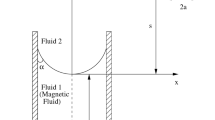Abstract
The superfluidity of water at 20–80°C in capillaries formed by quartz activated by grinding arises from quartz dissolution and from the interaction of the solution with the activated capillary surface. Superfluidity can be caused either by a decrease in the solution viscosity or by the sliding of the liquid along the capillary surface. Both mechanisms may be a consequence of the spatial structuring of the solution in the field of long-range surface forces.
Similar content being viewed by others
REFERENCES
Red'kina, N.I. and Khodakov, G.S., Superfluidity of Aqueous Solutions of Mechanically Activated Quartz in Capillary Porous Bodies, Teor. Osn. Khim. Tekhnol., 2001, vol. 35, no. 4, p. 360.
Khodakov, G.S., Fizika izmel'cheniya (Physics of Grinding), Moscow: Nauka, 1972.
Khodakov, G.S., Sorption Mechanochemistry of Inorganic Solids, Kolloidn. Zh., 1994, vol. 56, no. 1, p. 113.
Khodakov, G.S., Physicochemical Mechanics of Solid Grinding, Kolloidn. Zh., 1998, vol. 60, no. 5, p. 684.
Juyasz, A.Z. and Opoczky, L., Mechanical Activation of Mineral by Grinding, Budapest: Akademiai Kiado, 1990.
Avvakumov, E.G., Mekhanicheskie metody aktivatsii khimicheskikh protsessov(Mechanical Activation of Chemical Processes), Novosibirsk: Nauka, 1983.
Kerkis, E.E., Metody izucheniya fil'tratsionnykh svoistv gornykh porod (Methods for Studying the Filtration Properties of Rocks), Leningrad: Nedra, 1975, p. 85.
Aravin, V.I. and Numerov, S.N., Teoriya dvizheniya zhidkostei i gazov v nedeformiruemoi poristoi srede(The Theory of Fluid Motion in a Strain-Free Porous Medium), Moscow: Gosizdat, 1953, p. 49.
Kalashnikov, V.N., Polymer Solution Flow in a Pipe with a Variable Cross-Sectional Area, Preprint of Inst. for Problems of Mechanics, Acad. Sci. USSR, Moscow, 1980, no. 164.
Kalashnikov, V.N., Shear-Rate Dependence of the Viscosity of Dilute Polymer Solutions, Preprint of Inst. for Problems of Mechanics, Acad. Sci. USSR, Moscow, 1989, no. 378.
Kalashnikov, V.N. and Askarov, A.N., Relaxation Time of Elastic Stresses in Liquids Containing a Minor Amount of a Soluble Polymer, Inzh.–Fiz. Zh., 1989, vol. 57, no. 2, p. 198.
Kalashnikov, V.N., Shear-Rate Dependence of the Viscosity of Dilute Polymer Solution, J. Rheol., 1994, vol. 38, no. 5, p. 385.
Churaev, N.V., Fiziko-khimiya protsessov massoperenosa v poristykh telakh(Physics and Chemistry of Mass Transfer Processes in Porous Solids), Moscow: Khimiya, 1990.
Adamson, A., The Physical Chemistry of Surfaces, New York: Wiley, 1976.
Carman, P.C., Flow of Gases through Porous Media, London: Butterworths, 1956.
Khodakov, G.S., Osnovnye metody dispersionnogo analiza poroshkov(Basic Methods of the Particle-Size Analysis of Powders), Moscow: Stroiizdat, 1968.
Ekzoelektronnaya emissiya(Exoelectron Emission), Kobozev, N.I., Ed., Moscow: Inostrannaya Literatura, 1962.
Author information
Authors and Affiliations
Rights and permissions
About this article
Cite this article
Red'kina, N.I., Khodakov, G.S. Superfluidity of Aqueous Solutions in Capillaries at Ordinary Temperatures. Theoretical Foundations of Chemical Engineering 36, 531–538 (2002). https://doi.org/10.1023/A:1021297230191
Issue Date:
DOI: https://doi.org/10.1023/A:1021297230191



